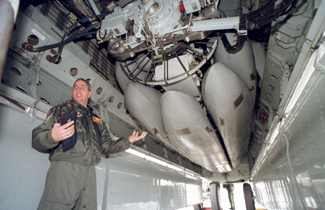| Home | Blog | Ask This | Showcase | Commentary | Comments | About Us | Contributors | Contact Us |

A B-52 with six armed nuclear missiles flew over the U.S. for 3-1/2 hours. What’s the story here?ASK THIS | September 252, 2007Defense expert Philip Coyle wants to know why these weapons were being moved in the first place, why they were sent to Barksdale Air Force Base, how long it was before the error was discovered and how many other such errors have there been. By Philip Coyle After years and years of U.S. government officials warning of the dangers of "loose nukes" and accusing Russia, Pakistan or other nations of not adequately controlling their nuclear weapons, we find that we have not one but six American loose nukes right here at home. Is this an exaggeration? Before you decide, imagine the outcry if Russia or some other nuclear weapons nation reported the same botched circumstances, the same incompetence. Confirming an article first published in Army Times on September 5 ("B-52 mistakenly flies with nukes aboard," Michael Hoffman, September 5, 2007), the U.S. Air Force has admitted that on August 30, 2007, a B-52 bomber took off from Minot AFB in North Dakota loaded with six nuclear weapons – Advanced Cruise Missiles designed to be launched from B-52 bombers - and landed three and a half hours later at Barksdale AFB in Louisiana. The Air Force has not permitted its bombers to overfly U.S. territory since the late 1960s when a series of nuclear weapons accidents involving the U.S. Air Force in this country and abroad created embarrassing scandals. [Click here for a review of these accidents published by the Center for Defense Information.] Except for all out nuclear war, nuclear weapons are supposed to be transported as cargo in specialized secure aircraft or trucks, not on operational aircraft. Advanced Cruise Missiles are slated for retirement, but the nuclear warheads are supposed to be removed first. According to the Washington Post ("In Error, B-52 Flew Over U.S. With Nuclear-Armed Missiles," Josh White, September 6, 2007), "The Stratofortress bomber, based at Minot Air Force Base in North Dakota, was transporting a dozen Advanced Cruise Missiles to Barksdale Air Force Base in Louisiana on Aug. 30. But crews inadvertently loaded half of them with nuclear warheads attached." Then, having been removed from their safe storage bunkers in North Dakota, those six nuclear weapons were loaded onto a B-52 bomber, flown hanging from the wing pylons of the bomber over at least six or seven of the United States for three and a half hours, and then parked on a runway ramp for another 10 hours, while no one in while no one in the White House, the Pentagon, or Air Force top leadership knew it. At best this means that for several hours, six nuclear weapons were unaccounted for, long enough for something else to have gone wrong. At worst one or more of those nuclear weapons might have been diverted or involved in a crash. Just one of those Advanced Cruise missiles can have a nuclear yield of as high as 150,000 tons of high explosive, ten times the bomb the U.S. dropped on Hiroshima. The Air Force maintains that the nuclear weapons were under their control the whole time, which may be technically correct, but such statements evade the central issue. Who was in charge and how did this happen? The Air Force appears to be trying to stonewall an independent investigation, and cites their policy to not comment on nuclear weapons matters to avoid providing information to the press. Nevertheless, the accident appears to have been the most complete and dangerous breakdown in the command and control of nuclear weapons in U.S. history. Reportedly Defense Secretary Gates and President Bush are both receiving daily briefings on what is being learned about how the accident happened and the status of the investigation. This is not surprising, given the utter seriousness of the matter. The incident was as astonishing to military experts as it was to members of Congress. In a joint statement, Reps. James H. Saxton (R-N.J.) and Terry Everett (R-Ala) put it succinctly, "As the lone superpower in the world, America must continue to lead by example and ensure our nuclear assets are protected with the highest safeguards." What made the accident so shocking is that the safety and security procedures around nuclear weapons are supposed to make it impossible for such an accident to happen. Every step is spelled out in exacting detail, rehearsed again and again, and examined in on-site inspections. A comment on the Military Times Web site, where now over 20 pages of comments have been accumulated, summed it up like this, "Having spent many years as an Air Force Munitions Troop both overseas and CONUS, working both locations with conventional and special weapons, I don't see how this could have happened. Everyone involved, and their chain of command, should be fired, and removed from PRP. There are far too many policies and procedures in place, that should have prevented this from happening." (The reference to the PRP is to the Personnel Reliability Program, a DOD directed program that insures the reliability and dependability of people working on nuclear weapons.) The Air Force has relieved the squadron commander in charge of Minot’s munitions crews of all duties pending the investigation, and called for a stand down to review safety and security procedures on September 17. Why the stand down was not ordered immediately after the August 30 incident has not been explained. On September 6th, columnist William Arkin, who keeps a close watch on the Pentagon, wrote, "…I would wager that if Congress wants to push the issue, we are going to find out that there have been hundreds of similar incidents over the years.” Hundreds? Egad. The accident is so bizarre, something that is not supposed to ever happen, that it has spawned conspiracy theories that those six nuclear weapons were part of a secret plan to bomb Iran, especially since Barksdale Air Force Base is a staging place for deployment to the Middle East. There are many questions the media should ask about this event. Without answers to them, no one can make positive recommendations for preventing such mishaps in the future. Questions Q. Why and for what ostensible purpose were these nuclear weapons taken to Barksdale AFB? Q. How long was it before the error was discovered? Q. How many mistakes and errors were made, and how many needed to be made, for this incident to happen. How many and which security protocols were overlooked and how many and which safety procedures were bypassed or ignored? Q. How many other nuclear command and control non-observations of procedure have there been? Is there in the U.S. government a consolidated data base of such incidents so that they could be counted? Who is responsible for such a data base? A report for the Center for Defense Information some time ago said President Kennedy was told in 1961 that there had been 60 U.S. nuclear weapons accidents. How many nuclear mishaps have there been since 1961? Q. What is the U.S. Congress going to do to better oversee U.S. nuclear command and control? Will there be an independent investigation of this mishap? Q. How does this incident relate to concern for reliability of control over nuclear weapons and nuclear materials in Russia, Pakistan, and elsewhere. Q. As some news reports suggest, does the Bush administration have plans to attack Iran with nuclear weapons? What does the U.S. Congress know about this, and have they even asked to be briefed? Click here for other Nieman Watchdog reports by Phil Coyle.
|
||||||||||||




